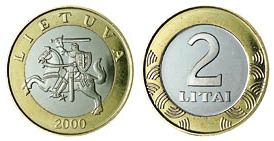Contrary to what Lithuania’s prime minister claims, discussions on euro introduction are far from over. They might be over for those who have had the task of convincing Lithuanians about the benefits of having the euro. Still, the euro will hardly stop bothering Lithuanians.
The decision regarding the euro adoption is much more complicated than a simple arithmetic calculation. Calculating how much we could save from a possible reduction in interest rates and currency exchange costs will not do. Just as it is not enough simply to estimate the costs of replacing accounting systems, launching pro-euro information campaigns or paying contributions to the European Financial Stability Fund. The issue of euro introduction is more complicated than that. It is related to the question about which government – Lithuanian or European – we trust more. In economic terms it does not matter what color the banknotes we exchange are. What really matters is for the money we use to properly perform its function.
Money performs its function badly if it devalues. People who remember or have read about the hyperinflation in Lithuania, Germany, Hungary or anywhere else know that currency devaluation is a guaranteed way to ruin an economy. We are witnessing the consequences of reckless monetary policy in today’s Belarus where currency devaluation is driving up prices, reducing people’s purchasing power, undermining stability and hampering the economy.
It is not only hyperinflation and soaring prices that is harmful. A continuous low-level inflation is just as detrimental. Price hikes, which are a perennial topic for discussion, are by and large caused by currency devaluation. And it is not greedy entrepreneurs who are to be blamed for perpetual annual price rises. Money supply increases as central banks multiply it through monetary policy and commercial banks, through fractional reserve banking. A growth in money supply means that the same amount of money can buy less and less. The more central banks increase the money supply, the more prices will grow.
The euro adoption will not trigger large and rapid price hikes. It is estimated that in countries which have joined the euro zone prices have grown by up to 0.3 percent. This means that in 2015 the price of a good that costs 10 litas will grow by an average of 20 cents due to the projected 2-percent inflation and by another 3 cents due to the euro introduction. This is not much, so the talks about a rapid decline in the purchasing power and an urgent need to raise the minimum wage are unjustified.
Still, euro-skeptics who are apprehensive of price rises are not completely wrong. The extent to which prices grow depends largely on the quality of money and the policies pursued by the money printing institution. Today the supply of the litas is tied under a currency board system to the amount of euros held at Lithuania’s central bank. Thanks to the currency board regime, the Bank of Lithuania is not allowed to discretionally augment the money supply and thus trigger a rise in prices. Prices in Lithuania are growing largely because the European Central Bank is increasing the money supply. Newly printed euros reach Lithuania – and hence increase the money supply – through EU support, money transfers back home by Lithuanians working abroad, foreign borrowing by the Lithuanian government and other means. Since the launch of the euro, the ECB has increased the supply of euros 3.3 times (much more than GDP growth). So even with a currency board in place the ECB is the source of price hikes in Lithuania.
Importantly, Lithuania today can choose an anchor for its currency. Before joining the EU, the litas was re-pegged from the dollar to the euro. If the euro were not the right anchor to secure a stable and credible local currency, there could be a more reliable option. So if we want to have lower price increases and a stable and credible litas, we need to ask ourselves which government – Lithuanian or European, and which central bank – Lithuanian or European, we trust more. This is not a simple question. For one thing, government policies are hard to predict. And secondly, the biggest threat to both the litas and the euro would occur if Lithuania and the EU were hit by a crisis, but then any forecasts would be even more difficult.
Those who do not want prices to grow should fear the devaluation of the litas and the abolition of the currency board, i.e. the removal of the peg and the central bank’s authority to increase the money supply. But similarly, after the euro introduction they should fear the ECB’s authority to print money, the authority which is almost unlimited and which the ECB exercised quite keenly to “stimulate” the economy during the recent crisis.
So the discussions on the euro introduction are not over, not only because the society is not unanimous on this issue, but also because not all critical aspects of euro adoption have been properly appraised. A solid opinion on the euro should not be confined to figures showing likely savings from interest rates or the costs of currency exchange. There might be no serious reason to trust Lithuanian politicians and to count on the re-pegging of the litas to a more reliable anchor before and in case the euro collapses. Rather, they might devalue the litas and start multiplying money. But counting on the bright future of the euro is not certain either. The euro is no longer what it used to be at the time of its birth. Likewise, it is crucial that once in the euro club, we avoid copying reckless policies of the countries that are living off debt, just as it is critical to have a firm position on what needs to be done in order to secure a strong euro and limited opportunities for the European Central Bank to multiply money.



